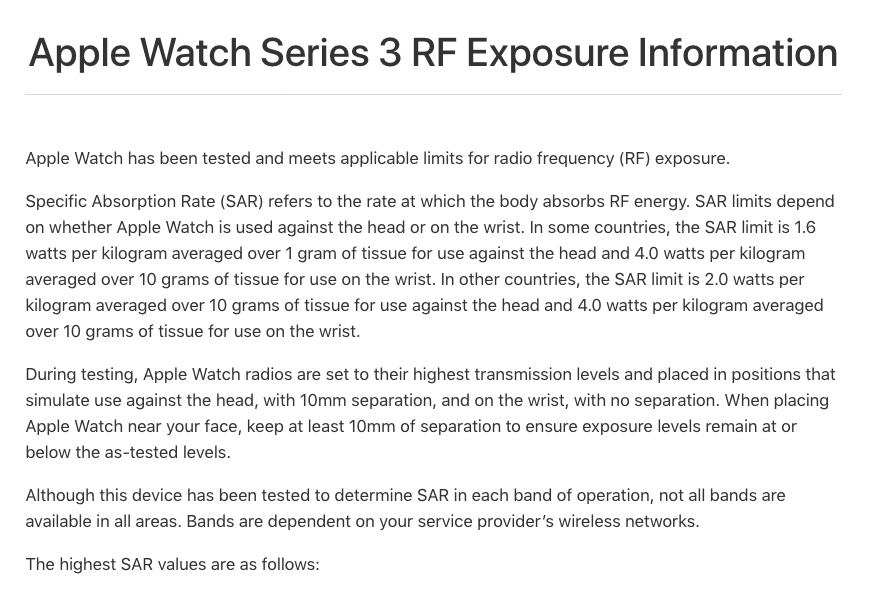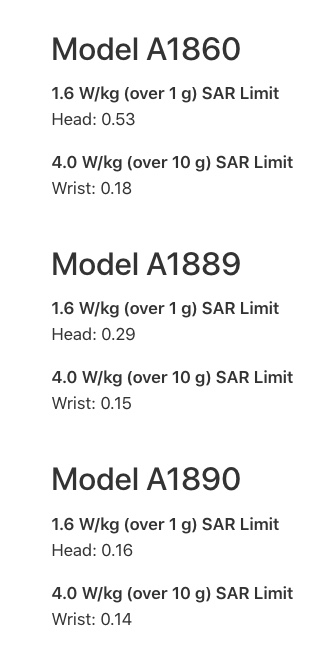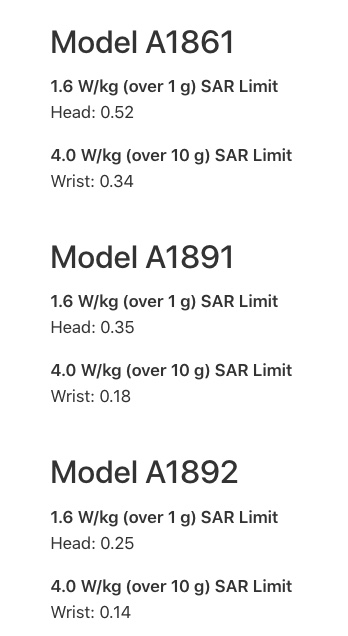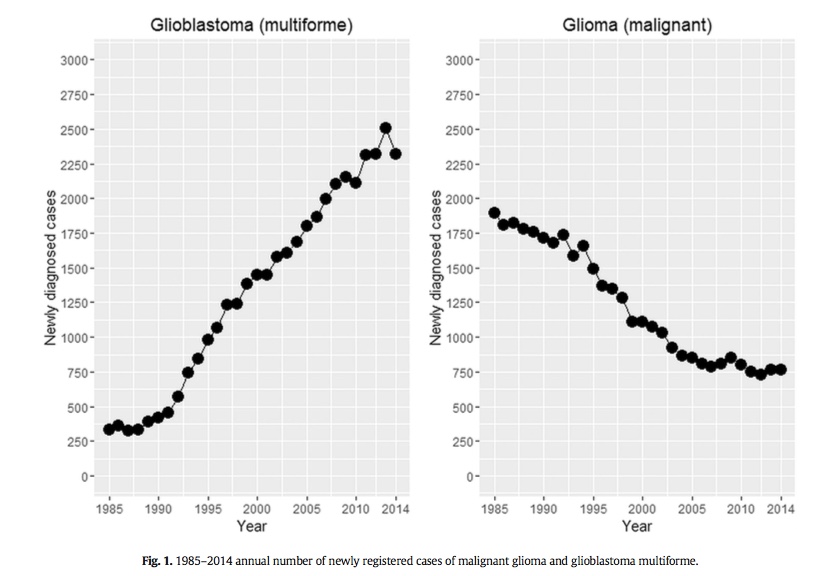2017 Short Takes
Highest SAR When Watch Is Held Next to the Head
Apple has released the RF exposure numbers —SARs, or specific absorption rates— for its new Series 3 Watches. These are the first wristwatches that can connect to cellular networks without being tethered to an iPhone.
The highest exposures, according to Apple, occur when the new watches are placed next to the head. The SAR measurements are based on a 10mm separation distance. The Model A1860 entails the highest exposure: 0.53 W/Kg averaged over 1g of tissue (0.52 W/Kg for the A1861).
The highest SAR on the wrist is 0.34 W/Kg for the A1861 (0.18 for the A1860). These SARs are measured without any separation from the wrist. Note that the SARs measured for the wrist are averaged over 10g of tissue.
The basic FCC SAR limit is pegged at 1.6 WKg averaged over 1g of tissue. Many European countries follow the ICNIRP guideline of 2.0 W/Kg averaged over 10g.
Averaging over the smaller volume (1g instead of 10g) can double or triple the maximum SAR (see MWN, J/A00, p.8, S/O01, p.10, and M/J03, p.4).
Here are the preamble and the SAR numbers that Apple posted on its Web site earlier today.





Apple has posted the SARs for its watches, phones and other products here.
The National Toxicology Program (NTP) will release the “complete results” of its $25 million project on cell phone cancer risks early next year, according to a statement posted on its Web site yesterday.
“The complete results from all the rats and mice studies will be available for peer review and public comment by early 2018,” the NTP states. The animals were exposed to GSM or CDMA radiation for two years before they were sacrificed and evaluated for signs of cancer.
The NTP report had been expected by the end of this year.
The final report has been highly anticipated since the spring of last year when the NTP announced that cell phone radiation increased the incidence of tumors in the brain and heart of male rats. At the time, the NTP posted some partial results from the rat experiments. No details of the mice studies have yet been made public. The early release followed a story on the findings in Microwave News.
NTP’s announcement of a cell phone–cancer risk attracted worldwide attention. The NTP results led the American Cancer Society and Consumer Reports, two organizations that had long been skeptical about a cancer link, to change their positions and advise caution in the use of wireless phones. Even so, many in the media, notably reporters at the New York Times and the Washington Post, expressed skepticism and told their readers to disregard the results. “Don’t Believe the Hype” ran the headline in the Washington Post. (See our “News Media Nix NTP Cancer Study.”)
The cell phone manufacturers —Apple, Google, Nokia (Microsoft) and Samsung— have all remained largely silent.
In addition to the animal studies, the NTP will release its findings showing DNA breaks in the brains of the male rats. The original plan was to publish those results as a stand-alone paper, but they will now be part of the general report.
One of the most commonly cited reasons to discount the NTP results has been that brain cancer rates have not been increasing in the general population. This may be true for all brain tumors combined, but it does not apply to the most virulent and deadly type, glioblastoma multiforme, better known as GBM. The incidence of GBM is rising in the U.S., as well as in other countries, including The Netherlands and the U.K. (Senator John McCain was recently diagnosed as having a GBM.)
GBM Going Up, Other Malignant Glioma Going Down
The incidence of glioblastoma multiforme (GBM), the most virulent and deadly type of brain cancer, is going up in the U.K., while the incidence there of other types of malignant brain tumors are declining, according to some newly published raw data.
Take a look at the two plots below and the trends are immediately apparent.
The incidence rates are not corrected for age, or any other factors. Better screening and diagnostics, the oft-cited explanations for an observed increase in a type of cancer, seems unlikely. Any such changes would probably affect all types of brain tumors. It is possible that the trends reflect the aging of the population, but that too seems doubtful since the likelihood of developing glioma increases with age once past the mid-teenage years.

Source: Frank de Vocht, "Corrigendum," Environment International, posted January 25, 2017
(GBM is a type of glioma, so the right-hand plot would be better titled “Malignant Glioma other than GBM”)
The new data come from a correction to a paper published last year by Frank de Vocht, a lecturer at Bristol University. That paper, an analysis of the possible impact of the use of mobile phones on brain tumor rates in the U.K., was based, in part, on “incorrect data,” prompting de Vocht to issue the “Corrigendum” with these two plots of brain tumor incidences.¹
De Vocht states that the correction had “no significant impact” on his conclusions. Yet, the two plots in the correction look very different from those with the same titles in the original paper.
We asked de Vocht to comment on the significance of the side-by-side plots. He demurred. “I don’t know enough about how mixes of different types of brain cancer subtypes/gliomas behave over time,” he told us. de Vocht encouraged us to talk to Alasdair Philips, the founder of Powerwatch who has been studying brain tumor rates in the U.K. and is preparing his own analysis for publication. Indeed, it was Philips who first spotted the error in de Vocht’s paper, which led to the correction.
Here’s what Philips told us: “The simple take-home message of the two plots is that the number of the most aggressive type of brain tumors [GBM] is going up and the other types of lower-grade malignant glioma are going down. If better diagnosis were responsible for the changes in GBM, then you would expect the two trends to be going in the same direction.”
“As GBM is almost always quickly fatal it is unlikely that they were misdiagnosed in the past,” Philips added. “It looks like something is causing or at least stimulating agressive glioma growth. Clearly, it is no longer enough to look only at overall brain tumor rates.”
While the new plots in themselves say nothing about any possible links between cell phones and brain tumors, they go a long way toward puncturing the argument offered by numerous public health officials and media outlets that such an association is highly unlikely because the overall incidence of brain tumors has remained relatively stable over the last number of years.
The same argument has also been used to discount the results of the NTP study, which shows that cell phone radiation increased cancer among rats. (See, for instance, this video from the New York Times.)
GBM has been rising in the U.S. as well as in other countries.
1. Here is the de Vocht’s conclusion from his original paper:
“A causal factor, of which mobile phone use (and possibly other wireless equipment) is in agreement with the hypothesized temporal association, is related to an increased risk of developing malignant neoplasms in the temporal lobe.”
